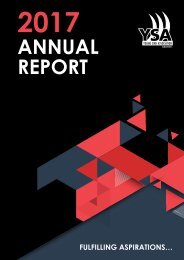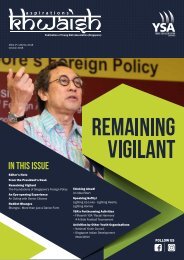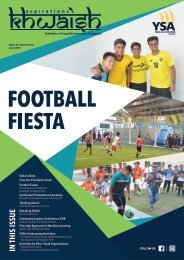YSA_NEWSLETTER__FEB_2018
Create successful ePaper yourself
Turn your PDF publications into a flip-book with our unique Google optimized e-Paper software.
Khwaish | February <strong>2018</strong><br />
13<br />
and bonds between early Sikh<br />
migrants and other settlers in 1930s<br />
Singapore. The film, ‘Singh in the<br />
Lion City’, by Upneet Kaur of Uptake<br />
Media also offered the opportunity<br />
to Ishvinder and me to share the<br />
journey behind the development of<br />
our mobile app. At the launch of the<br />
film, I also had the honour of sharing<br />
the panel with author Balli Kaur<br />
Jaswal as we discussed impressions<br />
and representations of Sikhs in various<br />
local mediums.<br />
Crucially, these projects have also<br />
been important avenues to introduce<br />
a wider audience to the myriad of<br />
histories and stories that animate the<br />
Singapore Sikh community today.<br />
The time is ripe in Singapore for such<br />
ventures. Having marked 50 years<br />
of national independence, many<br />
segments of the local community<br />
are looking back onto their own<br />
pasts. As each group does so, we<br />
find moments of interactions and<br />
exchange across ethnic, religious,<br />
class, and geographical lines. It is in<br />
these crossings that, I suggest, the<br />
heritage of Singapore is made and<br />
preserved.<br />
It is also at such crossings that I come<br />
closer to an answer for the question<br />
most frequently asked of me. Many<br />
are often curious why one of the Straits<br />
Tamil descends would choose to<br />
study an ‘unrelated’ community and<br />
region. This is certainly a fair question,<br />
and one that anthropologists ought to<br />
ask themselves. This seeming paradox<br />
was even the subject of an episode of<br />
Channel NewsAsia’s ‘On the Red Dot’<br />
that featured my work and story. I do<br />
not know if I will ever have a satisfying<br />
answer. (But no, it does not involve<br />
a nice Sikh boy.) What I can say for<br />
now is this – where there were many<br />
available paths, I took the one with<br />
the most questions.<br />
For anyone else who might be<br />
interested in taking up heritage work<br />
in Singapore, or any other passion<br />
project for that matter, I would say<br />
this – you do not have to have the<br />
answers yet, but be prepared for the<br />
questions. The time is now, the funding<br />
is there, with some comes more, there<br />
is support and more will find you, there<br />
are multiple ways to go about it and it<br />
all starts with starting.<br />
These starts that I have had with great<br />
collaborators have also led me here.<br />
In early 2017, I was invited to join the<br />
<strong>YSA</strong>’s Executive Committee by the<br />
current vice-president Sarabjeet<br />
Singh. Since Sarab was also the<br />
one who suggested I join Khwaish, I<br />
knew he would not steer me wrong.<br />
With <strong>YSA</strong>, I am currently working<br />
on ways to commemorate Sikh<br />
presence in Singapore as part of<br />
the 2019 Singapore Bicentennial.<br />
As with my other projects, I look<br />
forward to celebrating and creating<br />
more moments of interactions and<br />
exchanges with other communities.<br />
This too is where Singapore’s future<br />
lies – at the crossings, not in the<br />
categories.<br />
These are new shoes to fill, and I am<br />
honoured to walk in them. Since<br />
that cold morning on the parikrama<br />
of Harmandir Sahib, these feet<br />
have worn through multiple pairs<br />
of shoes that have been handed<br />
over to many a gentle sevadar<br />
at gurdwaras, whose soles have<br />
weathered the stony alleys and<br />
tarred highways of many Punjab<br />
summers, and whose laces have<br />
been embraced too fondly by love<br />
grass in Bukit Brown. As I step forward<br />
with <strong>YSA</strong> and continue working on<br />
celebrating Singapore’s heritage of<br />
exchange, I look forward to crossing<br />
paths with more of you. Come walk<br />
with me!<br />
Ms Vithya Subramaniam is a historian<br />
and anthropologist in training interested<br />
in questions of memory and space. Her<br />
primary research has focused on sites<br />
and objects across Punjab. Vithya holds<br />
degrees from Columbia University and<br />
the National University of Singapore<br />
(NUS). She currently seeks to inspire her<br />
students to ask better questions as a<br />
teaching assistant with the South Asian<br />
Studies Programme at NUS. The views<br />
presented in this article are personal and<br />
do not necessarily reflect those of <strong>YSA</strong>.






